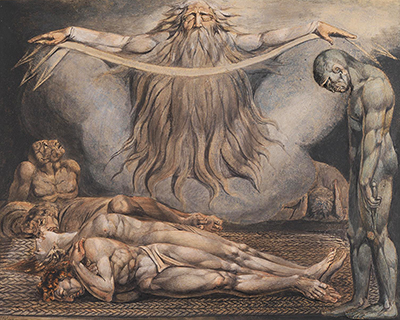The House of Death was produced by William Blake in approximately 1795–1805. It is a print which has then be finished off with touches of ink and watercolour over the top. The artist handsigned it, and then dated it at 1795, but that is not necessarily the correct date as learnt by experts from elsewhere in his career.
The striking imagery found here features an elderly man with his arms outstretched across the horizontal length of the painting. His eyes are closed and an abundance of beard hangs down. Around him are a series of figures looking desperate and in psychological pain. The colour scheme is suitably dark and there is little joy to be had here. William Blake went through different stylistic periods within his career, some of which were much brighter than this more sombre era. The artist was an exceptionally complex mind, and all sorts of different moods and personalities would appear from his subconscious over the course of his career. He embraced this, and attempted to draw out as much creativity as possible, regardless of whether it was positive or negative. That said, he did choose to work on bringing a greater brightness into his style a few years later, perhaps aware of the need to move on from this procession of darkly-themed artworks that not everyone would be fond of.
The inspiration for The House of Death was Book XI of Paradise Lost by John Milton. Many believe this English poet to have been Blake's favourite of all, hence the inspiration that he took for this artwork. The purpose of this composition is for Archangel Michael to demonstrate to Adam the consequences of his decision to eat the Forbidden Fruit. The punishment for this action would be delivered on Man itself, and he would have to sit and watch the reality of this harsh situation. Morality and guidance are key tenets of most religious teachings and this is perhaps one of the most famous displays of that. Blake worked for Butts on a number of projects, including this one, and Butts would be seen by many as his most important and supportive of patrons within his own lifetime. The poet and artist has since gained many new followers in the centuries that have passed since who continue to promote his impressive legacy.
This sombre artwork can today be found in the collection of the Tate, UK. They run a number of important art galleries throughout England, with Tate Britain and Tate Modern remaining the most visited. You will discover a large number of William Blake paintings here, though not all of them are out on permanent display in order to protect them in the long term - check ahead if there is a specific artwork that you want to see as you might need to arrange an appointment to see it in person. Visitors to the various galleries will still, however, be able to enjoy some of the best examples of British art in history, as well as a number of highly notable items from elsewhere in Europe and the US too. Stanley Spencer's The Resurrection, Cookham, William Holman Hunt's The Awakening Conscience and John Constable's Flatford Mill are just a few of the examples of exciting artworks to be found here.




